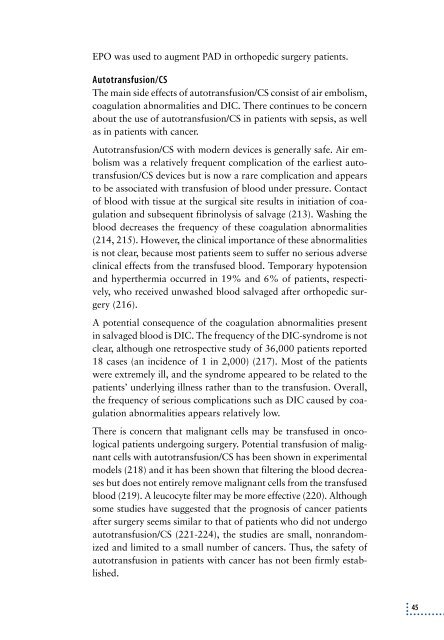Elektronisk udgave - Sundhedsstyrelsen
Elektronisk udgave - Sundhedsstyrelsen
Elektronisk udgave - Sundhedsstyrelsen
You also want an ePaper? Increase the reach of your titles
YUMPU automatically turns print PDFs into web optimized ePapers that Google loves.
EPO was used to augment PAD in orthopedic surgery patients.<br />
Autotransfusion/CS<br />
The main side effects of autotransfusion/CS consist of air embolism,<br />
coagulation abnormalities and DIC. There continues to be concern<br />
about the use of autotransfusion/CS in patients with sepsis, as well<br />
as in patients with cancer.<br />
Autotransfusion/CS with modern devices is generally safe. Air embolism<br />
was a relatively frequent complication of the earliest autotransfusion/CS<br />
devices but is now a rare complication and appears<br />
to be associated with transfusion of blood under pressure. Contact<br />
of blood with tissue at the surgical site results in initiation of coagulation<br />
and subsequent fibrinolysis of salvage (213). Washing the<br />
blood decreases the frequency of these coagulation abnormalities<br />
(214, 215). However, the clinical importance of these abnormalities<br />
is not clear, because most patients seem to suffer no serious adverse<br />
clinical effects from the transfused blood. Temporary hypotension<br />
and hyperthermia occurred in 19% and 6% of patients, respectively,<br />
who received unwashed blood salvaged after orthopedic surgery<br />
(216).<br />
A potential consequence of the coagulation abnormalities present<br />
in salvaged blood is DIC. The frequency of the DIC-syndrome is not<br />
clear, although one retrospective study of 36,000 patients reported<br />
18 cases (an incidence of 1 in 2,000) (217). Most of the patients<br />
were extremely ill, and the syndrome appeared to be related to the<br />
patients’ underlying illness rather than to the transfusion. Overall,<br />
the frequency of serious complications such as DIC caused by coagulation<br />
abnormalities appears relatively low.<br />
There is concern that malignant cells may be transfused in oncological<br />
patients undergoing surgery. Potential transfusion of malignant<br />
cells with autotransfusion/CS has been shown in experimental<br />
models (218) and it has been shown that filtering the blood decreases<br />
but does not entirely remove malignant cells from the transfused<br />
blood (219). A leucocyte filter may be more effective (220). Although<br />
some studies have suggested that the prognosis of cancer patients<br />
after surgery seems similar to that of patients who did not undergo<br />
autotransfusion/CS (221-224), the studies are small, nonrandomized<br />
and limited to a small number of cancers. Thus, the safety of<br />
autotransfusion in patients with cancer has not been firmly established.<br />
45

















